Export to File
Reading time ~6 minutes
The "Export to file" command exports the project to a multimedia format, such as AVI or QuickTime, for publishing or further editing.
Select the "Export to file" command from the Timeline or ClipBin context menu; the following dialog box appears:
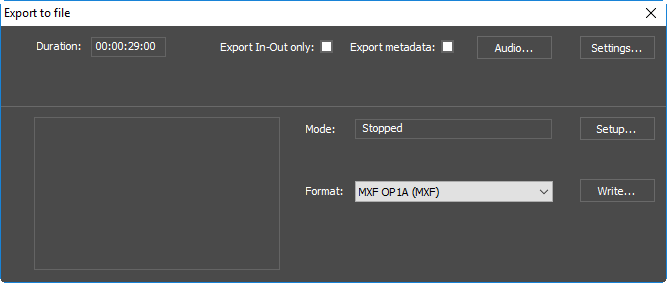
To export your project to file, do the following:
-
Select the format you want to use for your export. The set of available formats depends on your system configuration.
-
Press the "Setup" button to choose the options for the currently selected format. The selected exporter plug-in predefines the "Setup" dialog box; so this dialog box is different for each selected format.
-
Configure Audio settings.

The "Audio" option can be found in all the export options dialogs. Press the "Audio…" button and the following dialog box appears:
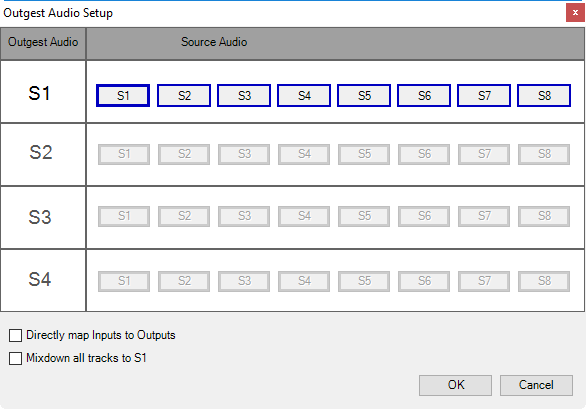 Note
NoteS1 – S4 stereo channels of the Sequence are displayed and routed within the "Outgest Audio Setup" dialog. In the case when destination file or format supports less than 4 stereo channels, only applicable outgest channels will be enabled. Here choose the audio tracks for each physical audio channel to accompany the outgest. The selected combination of audio tracks will be mapped to the defined outgest device.
Check the "Directly map Inputs to Outputs" option to map directly source audio tracks to the corresponding output tracks:
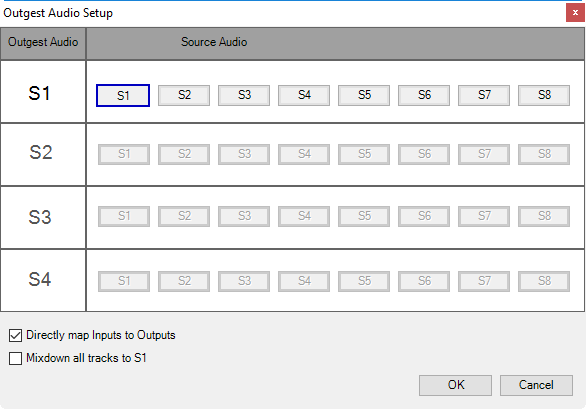
Check the "Mixdown all tracks to S1" option to mixdown all the source audio tracks to a single stereo output track (S1):
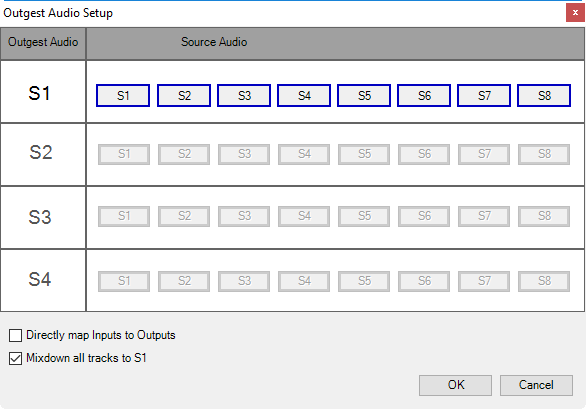
-
To export your project metadata, use the "Export metadata" option. The XML file will be generated with the same name as your media file and have the *.fidef extension.
-
Press the "Write" button. A common "Save as" dialog box appears. Choose your destination file and press "Save".
NoteThe export process might be time consuming, depending on the format and settings. The system displays a progress bar when exporting.
Microsoft Video
Select "Microsoft Video (AVI)" from the drop-down list. Press the "Setup" button to set up the format:
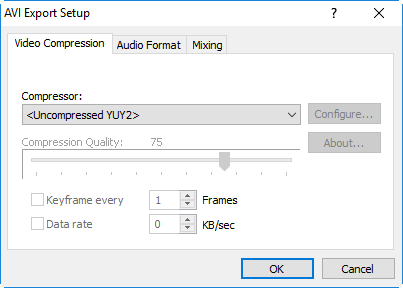
In the "Video compression" tab, choose one of the installed codecs from the drop-down list and define its compression settings by pressing the "Configure…" button.
|
Note
|
Press the "Configure" button to open the compression settings of the current codec. The compression settings are different for each codec. |
You can manually set the compression quality if the chosen codec supports this feature. A high value leads to a better quality and to slower compression speed as well.
Check the "Keyframe every" option to set the frequency of the keyframe creation.
Check the "Data rate" option to define its value in kilobit per second.
On the "Audio format" tab, configure the audio compression settings:
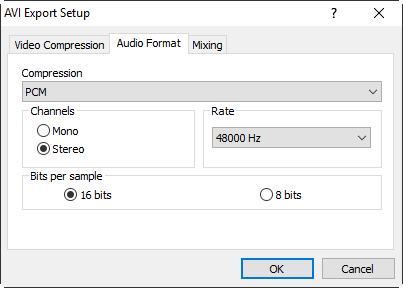
Choose one of the audio codecs from the drop-down list and configure its compression settings.
|
Note
|
The compression settings are different for each codec. |
The "Mixing" tab provides you with the interleaving configuration for the exporting stream:
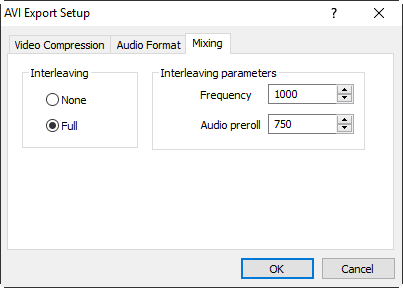
The "None" option disables the interleaving. To use the interleaving, set the radio button to "Full" and configure the interleaving parameters.
MP4 Flash
Setting up the MP4 Flash (MP4) export plug-in is similar to the MPEG export plug-in:
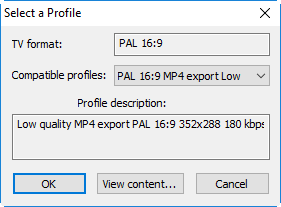
Here choose the H.264 export profile from the compatible profiles list.
Press the "View content…" button to view the settings of the MP4 profile.
MPEG
The MPEG export plug-in is sensitive to the format of the Sequence or ClipBin. If the Sequence has the 16:9 TV format, the export will provide only the corresponding MPEG profiles.

If there are no MPEG profiles available for the current TV format, the following error message will appear:
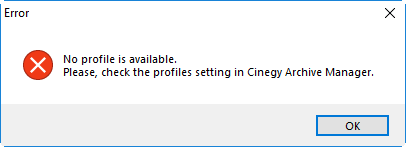
|
Important
|
Refer to the TV Formats, Profiles section of the Cinegy Archive Manager Manual for information on assigning TV formats for MPEG profiles. |
To view the settings of the MPEG profile, press the "View content…" button.
MXF AS-03
Select "MXF AS-03 (MXF)" from the drop-down list and press the "Setup" button to configure it. The following dialog box appears:
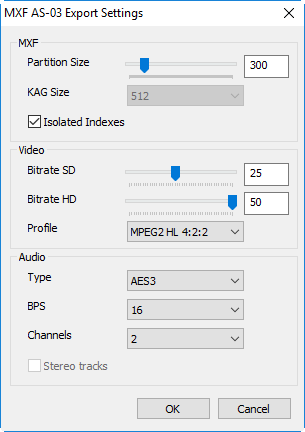
Here you can define the MXF, video and audio settings that will be used for the MXF AS-03 exporting.
MXF
The "MXF" configuration group comprises the advanced MXF parameters:
-
Partition Size – the size of the MXF partition. To define this parameter, drag the corresponding slider or enter the value from 50 to 1800 via the keyboard.
-
KAG Size – the value of the partitions alignment in the MXF file. This field is grayed out by default and cannot be changed by user.
-
Isolated Indexes – select the checkbox to write the indexes in a separate partition as it is outlined in the "AS-03 MXF Program Delivery" standard. When the "Isolated Indexes" option is not selected, the indexes are written together in the same partition as the video.
|
Important
|
Please visit amwa.tv/projects/AS-03.shtml for more information on the AS-03 MXF Program Delivery standard. |
Video
Here define the bitrate for the SD and HD streams by dragging the corresponding sliders or entering the desired values via the keyboard.
Also assign the MPEG-2 profile to be used for the MXF AS-03 exporting by choosing one from the drop-down list: MPEG2HL 4:2:0 or MPEG2HL4:2:2.
Audio
The "Type" and "BPS" fields are grayed out by default and cannot be changed by user.
Here you can define the number of mono channels to be used in your MXF file. To do this, choose 2, 4 or 8 from the "Channels" drop-down list.
The "Stereo tracks" option allows you to define the type of audio channels in your MXF file – mono or stereo. Select the "Stereo tracks" checkbox to receive 1, 2 or 4 (depending on your channels choice) stereo tracks in the exported MXF file. Alternatively, the resulting MXF file will contain 2, 4 or 8 mono channels.
MXF OP1A
Select "MXF OP1A (MXF)" from the drop-down list and press the "Setup" button to configure it. The following dialog box appears:
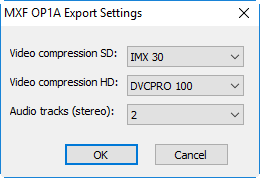
Here you can define the standard definition (SD) and high definition (HD) video compression settings as well as a number of stereo audio tracks that will be used for the MXF OP1A exporting by choosing the desired values from the corresponding drop-down lists.
The following standard definition compression settings are available:
-
IMX 30
-
IMX 40
-
IMX 50
-
DVSD
-
DV25
-
DV50
The following high definition compression settings are currently available:
-
DVCPRO100
The MXF OP1A encoder supports export of the material with up to 4 pairs of audio tracks.
Sound Export
To export only sound, select the "Sound export (WAV)" plug-in and press the "Write" button.
|
Note
|
The sound export has no settings. |
Windows Media
To export Windows media files, select "Windows Media (WMV, WMA)" from the drop-down list. To change the settings, press the "Setup" button and the following dialog box appears:

Here choose the desired profile from the drop-down list. Below you can view the description of the selected profile.
Select the "Multipass encoding" checkbox to enable multiple passes encoding.
|
Important
|
Refer to the TV Formats, Profiles, and Playout section of the Cinegy Archive Manager Manual to learn about Windows Media profiles. |